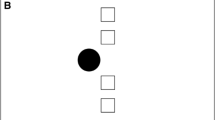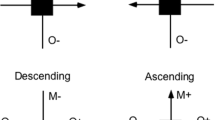Abstract.
Displacement in the remembered position of targets in displays based on Michotte's (1951/1991) tool effect paradigm was examined. Targets in tool effect displays exhibited less forward displacement than did otherwise identical targets presented in isolation; the decrease in forward displacement was not dependent upon the motion of a visible intermediary, but was dependent upon a visible intermediary contacting both the launcher and the target. The data were consistent with naïve impetus theory and the hypothesis that decreases in forward displacement of targets in tool effect displays resulted from the intermediary transferring perceived impetus of the launcher to the target and a dissipation of that impetus with subsequent target motion. Possible connections between displacement, impetus, and the perception of causality are discussed.
Similar content being viewed by others
Author information
Authors and Affiliations
Additional information
Electronic Publication
Rights and permissions
About this article
Cite this article
Hubbard, T.L., Favretto, A. Naïve impetus and Michotte's "tool effect": evidence from representational momentum. Psychological Research 67, 134–152 (2003). https://doi.org/10.1007/s00426-002-0122-5
Received:
Accepted:
Issue Date:
DOI: https://doi.org/10.1007/s00426-002-0122-5




